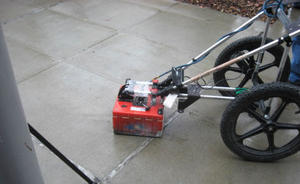InfrastructureBridges get a quick check-up with new imaging technique
EPFL engineers have developed a new imaging technique which allows engineers to see the insides of massive concrete bridges; much like a sonogram, this technique provides quick, easy-to-interpret images, so that the health of these expensive structures can be assessed and monitored

GeoRadar GPR here being used to find tree roots under a sidewalk // Source: seattle.gov
Bridges weigh several tons, they are typically hundreds of meters long, and are made of concrete reinforced by a skeleton of steel, but as is the case with living creatures, bridges sometimes have health problems.
Engineers from École Polytechnique Fédérale de Lausanne (EPFL) have developed an imaging technique which permits a quick and easy diagnosis of corrosion in the steel rebar skeleton, the most serious problem that these grand, artistic structures can encounter. This method will result in a considerable reduction in the cost and inconvenience of rehabilitation work.
An EPFL release reports that the process, developed as part of the Ph.D. research of Alexis Kalogeropoulos, is based on a technique known as “georadar,” which uses microwave radiation to penetrate the insides of the bridge. Numerical treatment of the data yields images that are precise and easy to interpret. The goal is to detect corrosion in the steel rebar — which is the primary weakness in structures made of reinforced concrete.
Concrete is a porous material. It is riddled with a network of tiny veins, barely a micrometer wide. “Even the best concretes have this defect,” explains professor Eugen Brühwiler, head of EPFL’s Structural Engineering Group, who led the study. Water infiltrates into the concrete through these tiny channels, carrying a variety of substances, such as chloride ions from salt used for de-icing, into the heart of the bridge. These substances gradually oxidize the steel rebar deep within the concrete. “The same problem occurs in concrete buildings near the ocean, where salt from sea spray is naturally present.”
Currently, the most widely used diagnostic method is to drill core samples from the bridge deck. A maximum of ten samples can be taken from a 100-meter bridge. “This method is too random to be able to precisely predict the magnitude and duration of rehabilitation, and thus to optimize the intervention,” explains Brühwiler.
For the past decade, Georadar has been used to get a better picture of what is going on. Mounted on a vehicle, a device sends radiation into the structure, then records the reflected signal. Much like a sonogram, this method gives engineers a look at the insides of the bridge — and allows them to diagnose various conditions such as construction defects, water pockets, and the presence of chloride ions. The drawback, like in medical applications, is that it takes an expert eye to be able to read the results. Brühwiler shows an image to demonstrate — a piece of a slab from a bridge, sliced up into irregular layers of several shades of gray. “In Switzerland there are only two or three people who are capable of interpreting this data, with at best an accuracy of 70 percent. I would be completely at a loss.”
The new data processing and analysis method makes the whole process much more precise and accessible. Images from the reflected signal are clear and readable. They allow engineers to detect rebar, water pockets, construction defects like gravel pockets, and above all, chloride ions, at a glance. “As is generally the case with this kind of method, we don’t detect the corrosion itself, but indirect effects, in this case, chloride ions,” explains Brühwiler. And in addition to facilitating interpretation of the results, the technique has been shown in the field to render diagnoses with an accuracy of more than 90 percent. The first successful application was carried out on a highway bridge in the canton Appenzell, and it will soon be repeated closer to EPFL as part of a project commissioned by the Swiss Federal Roads Office.
“It’s a world first,” says the researcher. “With our method, bridge rehabilitation will be easier to plan and the costs will be easier to determine.” It will be possible to scan an entire 100-meter bridge in just a few hours, and thus traffic disruption will be reduced. This research included contributions from scientists at EPFL, ETH Zurich, and Empa, which combined their expertise in fields such as materials science, measurement methods and signal processing.
